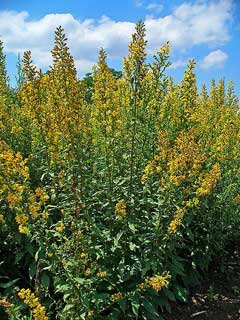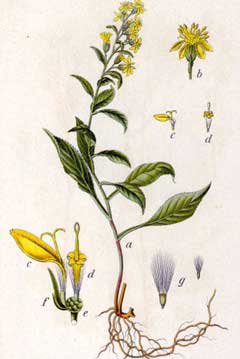 |
|
http://commons.wikimedia.org/wiki/User:Llez |
 |
| http://commons.wikimedia.org/wiki/File:Solidago_virgaurea_Sturm11.jpg |
Translate this page:
Summary
Physical Characteristics

 Solidago virgaurea is a PERENNIAL growing to 0.6 m (2ft) by 0.4 m (1ft 4in).
Solidago virgaurea is a PERENNIAL growing to 0.6 m (2ft) by 0.4 m (1ft 4in).
See above for USDA hardiness. It is hardy to UK zone 5. It is in flower from July to October, and the seeds ripen from August to October. The species is hermaphrodite (has both male and female organs) and is pollinated by Bees, flies. The plant is self-fertile.
It is noted for attracting wildlife.
Suitable for: light (sandy), medium (loamy) and heavy (clay) soils and can grow in heavy clay soil. Suitable pH: mildly acid, neutral and basic (mildly alkaline) soils. It can grow in semi-shade (light woodland) or no shade. It prefers dry or moist soil.
UK Hardiness Map
US Hardiness Map
Synonyms
Aster virgaurea. Dectis decurrens. Doria virgaurea. Solidago vulgaris
Plant Habitats
Woodland Garden Sunny Edge; Dappled Shade; Meadow; Hedgerow;
Edible Uses
Edible Parts:
Edible Uses: Tea
A tea is obtained from the leaves[46, 61, 183].
References More on Edible Uses
Medicinal Uses
Plants For A Future can not take any responsibility for any adverse effects from the use of plants. Always seek advice from a professional before using a plant medicinally.
Anthelmintic Anticoagulant Antifungal Antiinflammatory Antirheumatic Antiseptic Aromatic Astringent
Carminative Diaphoretic Diuretic Febrifuge Hypoglycaemic Stimulant TB
Urinary
Goldenrod is a safe and gentle remedy for a number of disorders. In particular, it is a valuable astringent remedy treating wounds and bleeding, whilst it is particularly useful in the treatment of urinary tract disorders, being used both for serious ailments such as nephritis and for more common problems such as cystitis[254]. The plant contains saponins that are antifungal and act specifically against the Candida fungus which is the cause of vaginal and oral thrush[238, 254]. It also contains rutin which is used to treat capillary fragility, and phenolic glycosides which are anti-inflammatory[238]. The leaves and flowering tops are anthelmintic, anti-inflammatory, antiseptic, aromatic, astringent, carminative, diaphoretic, mildly diuretic, febrifuge and stimulant[4, 7, 9, 21, 147, 165]. A good vulnerary herb, it has also proved of value when used internally in the treatment of urinary infections, chronic catarrh, skin diseases, influenza, whooping cough, bladder and kidney stones etc[4, 238]. Due to its mild action, goldenrod is used to treat gastro-enteritis in children[254]. It makes an excellent mouthwash in the treatment of thrush[7]. The plant is gathered in the summer and dried for later use[7]. The seed is anticoagulant, astringent and carminative[218]. A homeopathic remedy is made from the plant[9]. It is used in the treatment of kidney and bladder disorders, rheumatism and arthritis[9]. The German Commission E Monographs, a therapeutic guide to herbal medicine, approve Solidago virgaurea for infection of the urinary tract, kidney & bladder stones (see [302] for critics of commission E).
References More on Medicinal Uses
The Bookshop: Edible Plant Books
Our Latest books on Perennial Plants For Food Forests and Permaculture Gardens in paperback or digital formats.

Edible Tropical Plants
Food Forest Plants for Hotter Conditions: 250+ Plants For Tropical Food Forests & Permaculture Gardens.
More

Edible Temperate Plants
Plants for Your Food Forest: 500 Plants for Temperate Food Forests & Permaculture Gardens.
More

More Books
PFAF have eight books available in paperback and digital formats. Browse the shop for more information.
Shop Now
Other Uses
References More on Other Uses
Cultivation details
An easily grown plant, it succeeds in any moderately fertile moisture retentive soil in sun or semi-shade[200]. Grows well in heavy clay soils. A rather greedy plant, it is apt to impoverish the soil[1]. The bruised plant smells like wild carrots[4]. The sub-species S. virgaurea minuta is only 10cm tall and wide[188]. The plant attracts various beneficial insects such as ladybirds, lacewings and hoverflies to the garden, these insects will help to control insect pests in the garden[201, 238].
References Carbon Farming Information and Carbon Sequestration Information
Temperature Converter
Type a value in the Celsius field to convert the value to Fahrenheit:
Fahrenheit:
The PFAF Bookshop
Plants For A Future have a number of books available in paperback and digital form. Book titles include Edible Plants, Edible Perennials, Edible Trees,Edible Shrubs, Woodland Gardening, and Temperate Food Forest Plants. Our new book is Food Forest Plants For Hotter Conditions (Tropical and Sub-Tropical).
Shop Now
Plant Propagation
Seed - sow spring in a cold frame. Only just cover the seed and do not allow the compost to become dry. Prick out the seedlings into individual pots when they are large enough to handle, and grow them on for their first winter in pots. Plant them out into their permanent positions in spring or early summer. Division in spring or autumn. Larger divisions can be planted out direct into their permanent positions. We have found it best to pot up the smaller divisions and grow them on in a lightly shaded position in a cold frame, planting them out once they are well established in the summer.
Other Names
If available other names are mentioned here
Native Range
TEMPERATE ASIA: Afghanistan, Iran, Syria, Turkey, Russian Federation-Ciscaucasia (Ciscaucasia), Azerbaijan, Georgia, Russian Federation (Dagestan), Russian Federation-Western Siberia (Western Siberia), Russian Federation-Eastern Siberia (Eastern Siberia), Russian Federation (Altay), Kazakhstan, Kyrgyzstan, Tajikistan, Russian Federation-Far East (Far East), Russian Federation (Kurile Islands) TROPICAL ASIA: India (north), Nepal, Pakistan (north) EUROPE: Denmark, Finland, United Kingdom, Ireland, Norway, Sweden, Austria, Belgium, Switzerland, Czech Republic, Germany, Hungary, Netherlands, Poland, Slovakia, Russian Federation (European part), Belarus, Estonia, Lithuania, Latvia, Moldova, Ukraine (incl. Krym), Albania, Bulgaria, Bosnia and Herzegovina, Greece, Croatia, Italy (incl. Sardinia), North Macedonia, Montenegro, Romania, Serbia, Slovenia, Spain, France (incl. Corsica), Portugal AFRICA: Algeria, Morocco, Tunisia
Weed Potential
Right plant wrong place. We are currently updating this section.
Please note that a plant may be invasive in one area but may not in your area so it's worth checking.
Conservation Status
IUCN Red List of Threatened Plants Status :

| Related Plants
|
| Latin Name | Common Name | Habit | Height | Hardiness | Growth | Soil | Shade | Moisture | Edible | Medicinal | Other |
| Solidago canadensis | Canadian Goldenrod, Shorthair goldenrod, Harger's goldenrod, Rough Canada goldenrod, Common Goldenro | Perennial | 1.8 |
5-10
| M | LMH | SN | M | 2 | 2 | 1 |
| Solidago canadensis scabra | Canadian Goldenrod | Perennial | 1.8 |
3-7
| | LMH | SN | M | 2 | 2 | 2 |
| Solidago fistulosa | Pine barren goldenrod | Perennial | 1.8 |
0-0
| | LMH | SN | M | 0 | 1 | 2 |
| Solidago flexicaulis | Zigzag goldenrod | Perennial | 0.6 |
3-9
| M | LMH | FSN | DM | 0 | 0 | 3 |
| Solidago gigantea | Giant Goldenrod | Perennial | 1.2 |
5-9
| | LMH | SN | M | 0 | 2 | 1 |
| Solidago graminifolia | Flat-Topped Goldenrod | Perennial | 1.5 |
3-7
| | LMH | SN | M | 1 | 1 | 1 |
| Solidago japonica | | Perennial | 0.0 |
-
| | LMH | SN | M | 1 | 1 | 1 |
| Solidago leavenworthii | Leavenworth's goldenrod | Perennial | 1.2 |
-
| | LMH | SN | M | 0 | 1 | 2 |
| Solidago missouriensis | Prairie Goldenrod, Missouri goldenrod, Tolmie's goldenrod | Perennial | 1.2 |
6-9
| | LMH | SN | DM | 2 | 1 | 1 |
| Solidago nemoralis | Old-Field Goldenrod, Gray goldenrod | Perennial | 0.3 |
0-0
| | LMH | SN | DM | 1 | 1 | 1 |
| Solidago odora | Sweet Goldenrod, Anisescented goldenrod, Chapman's goldenrod | Perennial | 1.2 |
3-7
| | LMH | SN | DM | 2 | 2 | 2 |
| Solidago radiata | | | 0.0 |
-
| | LMH | SN | M | 1 | 1 | 1 |
| Solidago rigida | Stiff Goldenrod, Flat Topped Goldenrod, Stiff Goldenrod | Perennial | 1.2 |
3-9
| F | LMH | SN | M | 0 | 2 | 2 |
| Solidago spathulata | Coast Goldenrod, Creeping Goldenrod | Perennial | 0.6 |
4-9
| F | LMH | SN | M | 1 | 1 | 1 |
| Solidago spectabilis | Nevada Goldenrod | Perennial | 0.5 |
6-9
| | LMH | SN | M | 1 | 1 | 1 |
| Solidago suaveolens | anisescented goldenrod | Perennial | 0.0 |
-
| | LMH | SN | M | 1 | 1 | 1 |
|
Growth: S = slow M = medium F = fast. Soil: L = light (sandy) M = medium H = heavy (clay). pH: A = acid N = neutral B = basic (alkaline). Shade: F = full shade S = semi-shade N = no shade. Moisture: D = dry M = Moist We = wet Wa = water.
Now available:
Food Forest Plants for Mediterranean Conditions
350+ Perennial Plants For Mediterranean and Drier Food Forests and Permaculture Gardens.
[Paperback and eBook]
This is the third in Plants For A Future's series of plant guides for food forests tailored to
specific climate zones. Following volumes on temperate and tropical ecosystems, this book focuses
on species suited to Mediterranean conditions—regions with hot, dry summers and cool, wet winters,
often facing the added challenge of climate change.
Read More
Expert comment
Author
L.
Botanical References
17200
Links / References
For a list of references used on this page please go here
Readers comment
© 2010, Plants For A Future. Plants For A Future is a charitable company limited by guarantee, registered in England and Wales. Charity No. 1057719, Company No. 3204567.